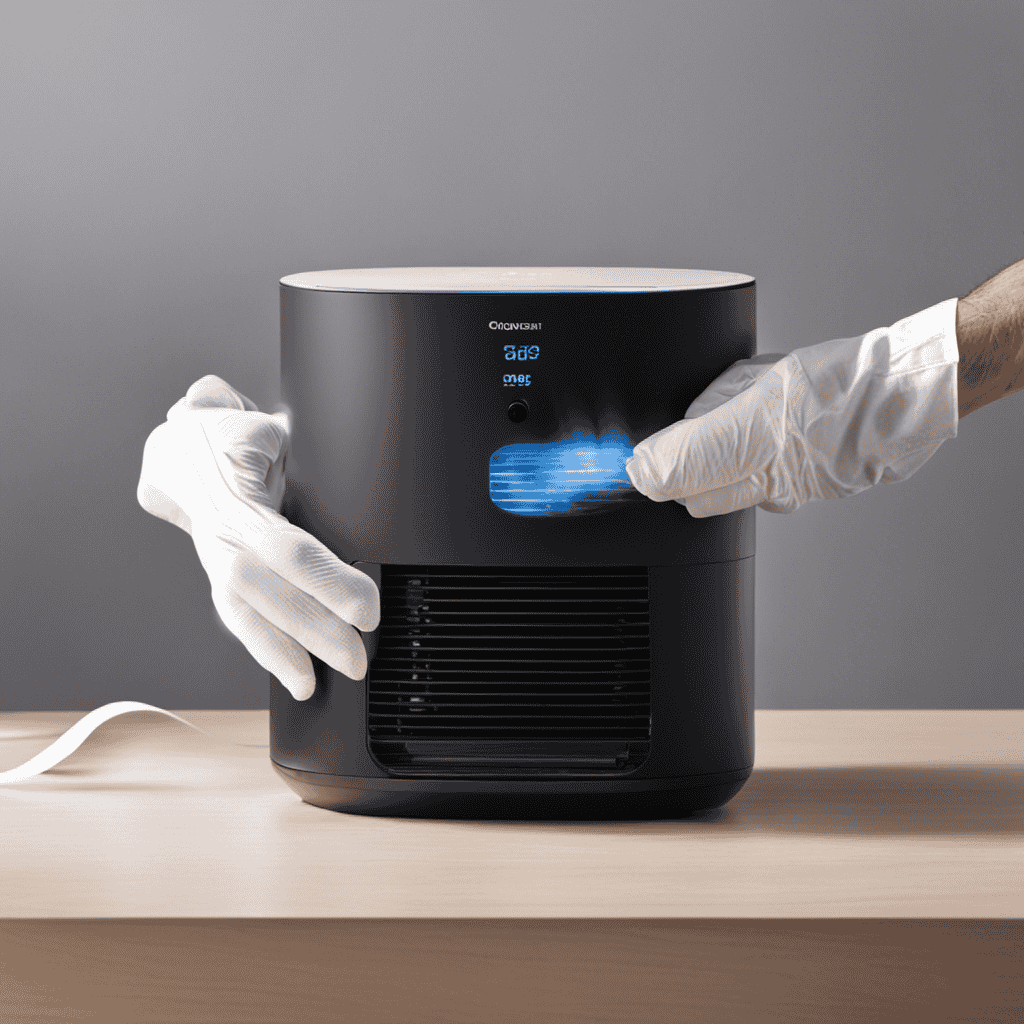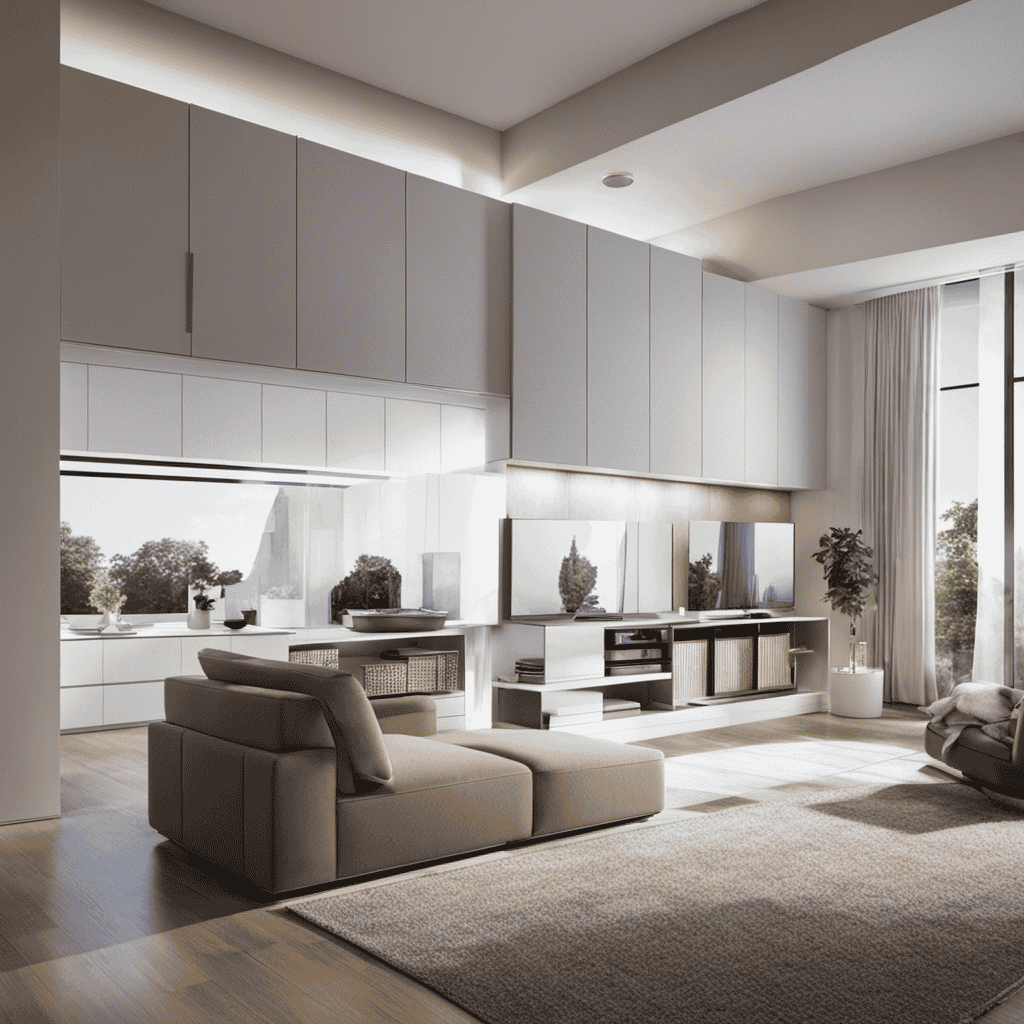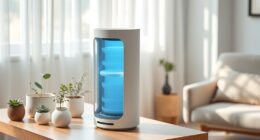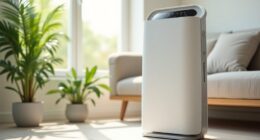I’ve been struggling with allergies for years, and my air purifier humidifier has been a lifesaver.
But recently, I noticed it wasn’t working as efficiently as before. That’s when I realized it was time to give it a thorough cleaning.
In this article, I’ll guide you through the step-by-step process of cleaning your air purifier humidifier, ensuring that it continues to provide clean and fresh air for your home.
Let’s get started!
Key Takeaways
- Inspect the device for visible signs of damage or buildup.
- Use the appropriate cleaning supplies and techniques to remove dust and debris from the intake vents and filters.
- Clean the water tank with a vinegar and water mixture to eliminate odors and remove mold or mineral buildup.
- Use mild cleaning solutions and eco-friendly options to clean the device, while avoiding harsh chemicals that can be harmful to the air purifier humidifier.
Assessing the Condition of Your Air Purifier Humidifier
To assess the condition of your air purifier humidifier, start by checking for any visible signs of damage or buildup. This is an important step in assessing the maintenance needs of your device. Look for cracks, leaks, or worn-out parts that may affect its performance.
Additionally, inspect the filters for any signs of dirt, dust, or clogs. These can hinder airflow and reduce the efficiency of the unit. Troubleshooting common issues such as strange noises, low mist output, or improper humidity levels should also be a part of your assessment.
Gathering the Necessary Cleaning Supplies
When it comes to cleaning, having the right tools is essential. In order to effectively clean, you will need a variety of tools such as microfiber cloths, brushes, and vacuum cleaners.
Additionally, it is important to use proper cleaning techniques to ensure that you are effectively removing dirt and grime.
Essential Cleaning Tools
You’ll need a few essential cleaning tools to properly clean your air purifier humidifier. Cleaning techniques and supplies are crucial to maintain the efficiency and performance of your device. Here are the top tools you’ll need:
| Cleaning Tools | Description |
|---|---|
| Soft-bristled brush | Used to remove dust and debris from the air intake vents and filters. |
| Microfiber cloth | Ideal for wiping down the exterior surfaces and removing any residue or smudges. |
| Q-tips | Perfect for reaching small and delicate areas, such as the sensor or control panel. |
These tools will allow you to effectively clean your air purifier humidifier and ensure the longevity of its components. Remember to follow the manufacturer’s instructions for cleaning and maintenance, as each device may have specific requirements. Regular cleaning will keep your air purifier humidifier running at its best, providing you with clean and fresh air in your home or office.
Proper Cleaning Techniques
Using a soft-bristled brush, gently remove any dust or debris from the intake vents and filters of your device. Regular cleaning is essential to maintain the efficiency and performance of your air purifier humidifier.
Here are some proper cleaning techniques to consider:
-
Assessing maintenance needs:
-
Check the filter indicator to determine when it needs replacement.
-
Inspect the water tank for any signs of mold or mineral buildup.
-
Troubleshooting common issues:
-
If the device is not producing enough mist, check the water level and ensure the water tank is properly seated.
-
If there is an unpleasant odor, clean the water tank with a mixture of vinegar and water.
Recommended Cleaning Products
To effectively clean and maintain your device, it’s recommended to use mild cleaning solutions and microfiber cloths. These cleaning options are not only effective but also eco-friendly, ensuring that you are being mindful of the environment while keeping your air purifier humidifier in top condition. Here are some recommended cleaning techniques and eco-friendly options:
| Cleaning Technique | Eco-Friendly Option |
|---|---|
| Wiping | Vinegar |
| Disinfecting | Lemon Juice |
| Removing Stains | Baking Soda |
| Deodorizing | Tea Tree Oil |
Using these eco-friendly cleaning options not only helps to keep your device clean but also eliminates the need for harsh chemicals that can be harmful to both your device and the environment. Now that your device is clean, it’s time to move on to the next step: turning off and unplugging the device.
Turning Off and Unplugging the Device
When it comes to cleaning and maintaining your air purifier humidifier, it is crucial to prioritize safety precautions. This includes wearing protective gloves and goggles to prevent any potential harm from cleaning solutions or debris.
Additionally, following proper maintenance procedures ensures the longevity and efficiency of your device, reducing the risk of malfunctions and improving indoor air quality.
Safety Precautions While Cleaning
Remember, always unplug the air purifier humidifier before cleaning to ensure your safety. Cleaning frequency is an essential aspect of maintaining the device’s efficiency and preventing potential hazards.
When cleaning the air purifier humidifier, it is crucial to follow these safety precautions:
- Use mild soap and water to clean the external surfaces, ensuring that no liquid enters the device’s internal components.
- Gently remove the filters and rinse them under running water. Allow them to air dry completely before reinserting.
- Take extra care when handling the filters to avoid damaging the delicate fibers.
- If the filters are heavily soiled or damaged, consider replacing them with new ones.
By adhering to these safety measures, you can prevent any accidents or damage while cleaning your air purifier humidifier.
Now, let’s delve into the importance of proper maintenance for optimal performance and longevity.
Importance of Proper Maintenance
Taking care of the device through regular maintenance ensures that it operates efficiently and lasts longer. Proper maintenance is crucial for preventing mold growth and troubleshooting common issues that may arise with an air purifier humidifier. By following a few simple steps, you can keep your device in optimal condition. Here are some maintenance tasks to consider:
| Maintenance Task | Frequency |
|---|---|
| Clean the filters | Every 1-3 months |
| Empty and clean the water tank | Weekly |
| Check for leaks | Monthly |
| Inspect the fan blades | Bi-annually |
Regularly cleaning the filters helps maintain the device’s effectiveness in purifying the air and preventing mold growth. Emptying and cleaning the water tank ensures that no stagnant water or bacteria accumulate. Checking for leaks helps identify any potential issues early on, while inspecting the fan blades ensures proper airflow. By incorporating these maintenance tasks into your routine, you can ensure that your air purifier humidifier functions optimally, preventing mold growth and addressing common issues before they become major problems.
Disassembling the Air Purifier Humidifier
To disassemble the air purifier humidifier, start by unplugging it from the power source. This ensures your safety during the disassembling process. Once unplugged, follow these troubleshooting tips:
-
Remove the water tank: The water tank is usually located at the base of the unit. Twist the tank counterclockwise to unlock it, then carefully lift it out.
-
Detach the filters: Filters are crucial components that capture impurities and maintain air quality. Usually, there are two types of filters: the pre-filter and the HEPA filter. Remove them by gently pulling them out of their designated slots.
-
Take apart the fan and motor assembly: Locate the screws that secure the fan and motor assembly in place. Use a screwdriver to loosen and remove them. Carefully lift the assembly out of the unit.
-
Disassemble the remaining components: Depending on the model, there may be additional components such as the UV light or ionizer. Refer to the user manual for specific instructions on how to remove them.
Remember to handle each part with care and refer to the user manual for any uncertainties.
Cleaning the Water Tank
When it comes to cleaning the water tank of an air purifier humidifier, there are several key points to consider.
First, it is important to remove mineral deposits that can accumulate over time. This can be done using a mixture of vinegar and water or a descaling solution specifically designed for humidifiers.
Secondly, preventing bacteria growth is crucial for maintaining a healthy environment. Regularly disinfecting the water tank with a mild bleach solution or using a silver ion cartridge can help inhibit the growth of harmful bacteria.
Lastly, proper drying techniques should be employed to prevent the formation of mold and mildew. After cleaning, ensure that the water tank is thoroughly dried before reassembling the air purifier humidifier.
Removing Mineral Deposits
You’ll want to start by unplugging the air purifier humidifier and emptying out any remaining water to prevent any further mineral deposits from forming. Scale buildup and mineral stains can be unsightly and can also affect the performance of your air purifier humidifier.
To effectively remove mineral deposits, follow these steps:
- Mix equal parts white vinegar and water in a container.
- Dampen a clean cloth or sponge with the vinegar solution.
- Gently scrub the affected areas of the air purifier humidifier, focusing on the mineral stains.
- Allow the vinegar solution to sit on the stains for a few minutes to loosen the deposits.
- Rinse the cloth or sponge thoroughly and wipe away the vinegar solution.
- Repeat the process if necessary until the mineral deposits are completely removed.
- Once the mineral deposits are gone, rinse the air purifier humidifier with clean water and dry it thoroughly before plugging it back in.
Following these steps will help you maintain a clean and efficient air purifier humidifier, free from scale buildup and mineral stains.
Preventing Bacteria Growth
Regular maintenance is essential for ensuring that bacteria does not grow in your air purifier humidifier. Bacteria growth can lead to various health issues and compromise the air quality in your home.
To prevent such problems, it is crucial to follow a few simple steps. Firstly, clean the water tank regularly using a mixture of mild detergent and warm water. This will help remove any bacteria or mold that may have formed.
Secondly, replace the filters as recommended by the manufacturer to ensure optimal performance and prevent the buildup of bacteria.
Additionally, make sure to empty and dry the water tank when not in use to prevent stagnant water and bacterial growth.
Proper Drying Techniques
To prevent bacterial growth, make sure to thoroughly dry the water tank after each use. This step is crucial in preventing mold growth and avoiding water damage. Here are some techniques to ensure proper drying:
- Remove the water tank from the humidifier unit.
- Empty any remaining water from the tank.
- Use a clean cloth or towel to wipe the inside of the tank, removing any moisture.
- Leave the tank to air dry in a well-ventilated area for at least a few hours.
- Once dry, reassemble the humidifier and store it in a cool, dry place.
By following these proper drying techniques, you can effectively prevent mold growth and maintain the longevity of your humidifier.
Now, let’s move on to the next step: cleaning the air filter.
Cleaning the Air Filter
Don’t forget to regularly clean the air filter in your air purifier humidifier to ensure optimal performance. The air filter plays a crucial role in purifying and humidifying the air in your home, so it is essential to keep it clean and free from dust and debris. Neglecting to clean the air filter can lead to reduced airflow, decreased efficiency, and even potential damage to the unit. To assess the maintenance needs of your air filter, refer to the manufacturer’s instructions for recommended cleaning intervals. Common issues that may arise due to a dirty air filter include decreased humidity levels, increased energy consumption, and poor air quality. By regularly cleaning and maintaining the air filter, you can troubleshoot these issues and ensure that your air purifier humidifier operates at its best.
| Maintenance Tips | Troubleshooting Common Issues | Manufacturer’s Recommendations |
|---|---|---|
| Clean the air filter regularly | Decreased humidity levels | Follow the recommended cleaning intervals |
| Remove dust and debris from the filter | Increased energy consumption | Refer to the manufacturer’s instructions |
| Check for any signs of damage | Poor air quality | Replace the air filter if necessary |
| Ensure proper airflow | Regularly assess the condition of the filter | |
| Follow manufacturer’s recommendations |
Cleaning the Humidifier Base
Make sure you regularly inspect and clean the base of your humidifier to prevent the buildup of dirt and bacteria. The cleanliness of your humidifier base is essential for maintaining its efficiency and ensuring the air you breathe is free from harmful contaminants. Here are some steps to assess the cleanliness and perform proper disinfection:
- Inspect: Carefully examine the base of your humidifier for any visible dirt, mold, or mineral deposits.
- Dirt buildup: Look for any clogged or obstructed parts that may hinder the proper functioning of the humidifier.
- Bacteria growth: Check for any signs of biofilm or slimy residue that can harbor harmful bacteria.
Clean: Use a mild detergent and warm water to clean the base thoroughly. Scrub any stubborn dirt or mineral deposits with a soft brush.
Removing Mineral Deposits and Scale Buildup
Regularly inspecting and cleaning the base of my humidifier helps prevent the buildup of mineral deposits and scale. This is crucial for maintaining its efficiency and preventing mold growth.
To remove limescale buildup, I follow a simple process. First, I unplug the humidifier and remove the water tank. Then, I carefully detach the base from the unit. Using a soft brush, I gently scrub the base with a mixture of water and vinegar. This solution helps dissolve the mineral deposits and scale.
After scrubbing, I rinse the base thoroughly with clean water and allow it to dry completely before reattaching it. By regularly removing limescale and mineral deposits, I ensure that my humidifier remains clean, mold-free, and functions optimally.
Cleaning the Exterior Surfaces
To keep your humidifier in good condition, there are a few simple cleaning techniques you can follow. First, regularly wipe down the exterior surfaces with a soft cloth. This will help remove dust, dirt, and other particles that can accumulate on the surface. For a more thorough cleaning, you can use a mild detergent mixed with warm water to remove any stubborn stains. Just make sure to avoid using harsh chemicals or abrasive scrubbers as they can damage the finish of your humidifier.
When cleaning the exterior surfaces, it’s important to pay special attention to a few key areas. Start with the control panel. Use a cotton swab dipped in a mixture of water and vinegar to gently remove any residue or buildup. Next, focus on the water tank. Empty and rinse the tank thoroughly, ensuring there are no traces of mineral deposits or mold. Finally, consider using recommended cleaning products specifically designed for humidifiers. If you don’t have those on hand, mild dish soap and water can be used as an alternative.
Drying and Reassembling the Device
After cleaning the exterior surfaces, you can now dry and reassemble the device.
Proper storage is crucial to maintain the effectiveness of your air purifier humidifier.
Start by drying all the components thoroughly. Use a clean, dry cloth to remove any moisture. Make sure to pay attention to the air vents and filters, as they can trap moisture.
Once the device is completely dry, reassemble it carefully according to the manufacturer’s instructions. Ensure that all the parts fit securely and are aligned properly.
Before storing, check for any signs of damage or wear. If you notice any issues, consult the troubleshooting tips provided by the manufacturer.
Finally, store the device in a cool, dry place away from direct sunlight and extreme temperatures.
Following these steps will help prolong the lifespan of your air purifier humidifier.
Performing Regular Maintenance to Extend the Lifespan
Performing regular maintenance on your device can help extend its lifespan and ensure optimal performance. To keep your device running smoothly, here are some cleaning techniques you can utilize:
-
Cleaning the filters:
-
Gently remove the filters from the device.
-
Use a soft brush or vacuum to remove dust and debris.
-
Rinse the filters with lukewarm water and allow them to air dry completely before reinserting.
-
Wiping the exterior:
-
Use a damp cloth or mild cleaning solution to wipe the exterior of the device.
-
Pay special attention to vents and openings to remove any accumulated dirt or grime.
By regularly cleaning the filters and wiping the exterior, you can prevent clogging and ensure efficient airflow, thus extending the lifespan of your device.
Remember to consult the manufacturer’s instructions for specific cleaning guidelines.
Frequently Asked Questions
How Often Should I Clean My Air Purifier Humidifier?
I clean my air purifier humidifier regularly to maintain its efficiency. Cleaning the filters is crucial in removing dust, allergens, and other pollutants from the air. Regular maintenance ensures the device works effectively and promotes better indoor air quality.
Can I Use Vinegar to Clean the Water Tank?
Yes, vinegar can be used as an effective cleaning solution alternative to remove mold and sanitize the water tank of an air purifier humidifier. It is a natural and affordable option.
What Should I Do if My Air Filter Is Damaged?
If my air filter is damaged, I should first inspect it for any visible signs of wear or tear. If it can be repaired, I will do so following the manufacturer’s instructions. If it cannot be repaired, I will replace it with a new one.
Is It Necessary to Clean the Exterior Surfaces of the Device?
Cleaning the exterior surfaces of the device is important to maintain its efficiency and prevent the buildup of dust and debris. Regular cleaning methods, such as wiping with a damp cloth, can help prolong the lifespan of your air purifier humidifier.
How Do I Prevent Mineral Deposits and Scale Buildup in My Air Purifier Humidifier?
To prevent mineral deposits and scale buildup in my air purifier humidifier, I follow best cleaning practices. This includes regular cleaning of the water tank, using distilled water, and ensuring proper ventilation to prevent mold growth.
Conclusion
In conclusion, maintaining a clean air purifier humidifier is essential for ensuring optimal performance and prolonging its lifespan.
By regularly cleaning the water tank and removing mineral deposits, you can prevent the buildup of harmful bacteria and maintain clean, fresh air in your home.
Did you know that according to a study conducted by the Environmental Protection Agency (EPA), indoor air can be up to five times more polluted than outdoor air?
Therefore, investing time in cleaning your air purifier humidifier is crucial for improving indoor air quality and promoting a healthier living environment.










